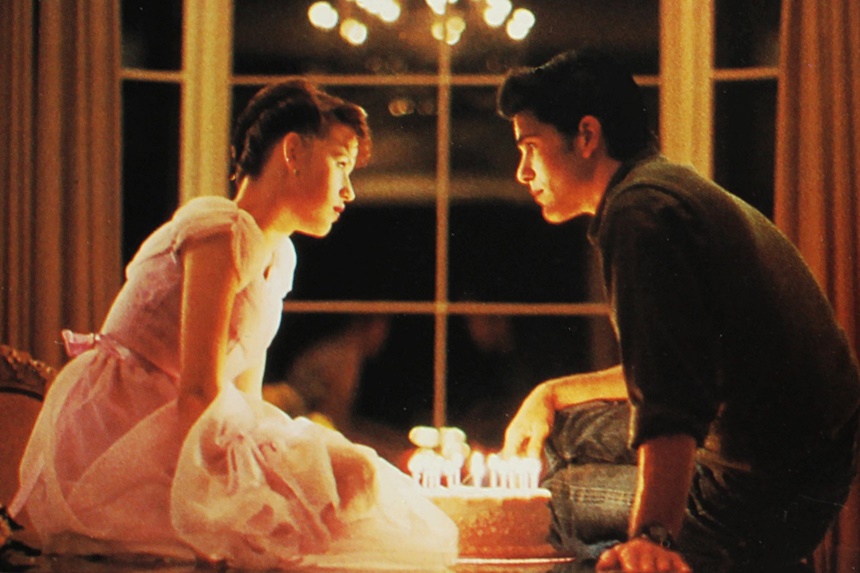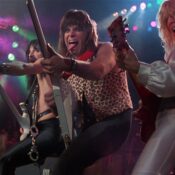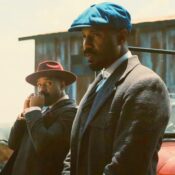Forty years ago this week, the directorial debut of John Hughes opened in theaters. Hughes would redefine the teen comedy, applying a new kind of poignancy that reflected the concerns of Generation X while treating the kids as actual people and not mere props for punchlines. At the same time, he discovered or provided a boost to a number of young actors who continue to have an impact on the business today. Here are ten things you should know about Sixteen Candles.
1. From Jokes to Ads to The Lampoon
John Hughes got his start in entertainment writing jokes for stand-up comedians like Joan Rivers and Rodney Dangerfield. He parlayed that experience into writing ad copy, securing work at different firms. Work trips put him in proximity to the offices of National Lampoon magazine, and he was able to successfully pitch work for the subversive humor publication.
2. Working Vacation
Trailer for National Lampoon’s Vacation (Uploaded to YouTube by Rotten Tomatoes Classic Trailers)
Among Hughes’s many contributions to the magazine was a story called “Vacation ’58,” which detailed a family trip. After writing the screenplay for Lampoon’s unsuccessful Class Reunion, Hughes took another swing with an updated version of his earlier family article, this time titled National Lampoon’s Vacation. Both Vacation and another Hughes script, Mr. Mom, were huge comedy hits in 1983. That break-out success secured him a writing and directing deal with Universal.
3. False Start
Hughes had written a version of Sixteen Candles as early as 1982, but circumstances dictated that other projects happen first. As Molly Ringwald told CBS News, when Hughes circled back to the project, he requested head shots of young actresses who might be a suitable lead. When he saw Molly Ringwald, he pictured her as Samantha “Sam” Baker, a teen adrift in romantic complications as her family forgets her birthday due to her sister’s wedding, and wrote what was essentially the final version of the film over a weekend.
4. Making Molly
Trailer for Sixteen Candles (Uploaded to YouTube by Rotten Tomatoes Classic Trailers)
Ringwald was no stranger to show business when she entered Hughes’s orbit. She recorded an album with her dad’s jazz band at six and was performing in the West Coast production of Annie by age 10. In 1979, she guested on Diff’rent Strokes and joined the first-season cast of The Facts of Life. Ringwald lost that job in the show’s second season retooling but made the jump to the big screen with Paul Mazursky’s Tempest in 1982 and the 3-D revival science fiction film Spacehunter: Adventures in the Forbidden Zone in 1983. Sixteen Candles was to be her first leading role.
5. Farming Ted
The role of Ted Farmer, alternately referred to as Farmer Ted or “The Geek,” went to Anthony Michael Hall. Hughes had previously cast Hall as Rusty Griswold in Vacation. He and Ringwald shared several elements of their childhood: Hall’s mother was a jazz (and blues) singer, and he found early work in commercials and on stage. From there he jumped to TV movies and a more noticeable role alongside Kenny Rogers and young Diane Lane in 1982’s Six Pack. In Hall, Hughes found an alter ego, essentially casting the young actor as the teen version of himself across four films (Vacation, Sixteen Candles, The Breakfast Club, Weird Science).
6. Finding Jake Ryan
For the male romantic lead, Hughes cast Michael Schoeffling. The actor made his feature debut in the film after several years of modeling and actor training (including the Strasberg school in NYC). Schoeffling made ten more films between 1984 and 1991 before leaving the business. He now creates handcrafted furniture.
7. A Film Full of Breakouts
Hughes’s uncanny knack for casting future stars was on full display in Candles. Among the actors making their film debuts or early film appearances: John Cusack, Joan Cusack, Jami Gertz, Gedde Watanabe, Liane Curtis, Tony Longo, and Haviland Morris.
8.Soundtrack Mystic
While Hughes has long been held in high regard for the music he selected for his films, the decisions around actual soundtrack albums could be strange. (For instance, Ferris Bueller’s Day Off had no official soundtrack release until 30 years after the movie, and that was limited to 5,000 copies.) In the case of Sixteen Candles, the soundtrack album was only a five-song mini-album, despite the fact that the film features an addition 28 songs or instrumental pieces. The music heard in Sixteen Candles had a few classic tracks and TV theme song references (like “The Theme from Peter Gunn”), but was primarily composed of of-the-moment acts like Thompson Twins, Billy Idol, General Public, Spandau Ballet, Stray Cats, The Specials, and Oingo Boingo.
9. Game Changer
Trailer for The Breakfast Club (Uploaded to YouTube by Rotten Tomatoes Classic Trailers)
The 1980s had been full of teen movies prior to Sixteen Candles. The marked difference between many of those films and the work of Hughes was that many of the others were over-the-top sex comedies. Movies like Private Lessons and Porky’s relied heavily on sexual situations without a ton of character development, and the films that were stretching for more (like Fast Times at Ridgemont High or The Last American Virgin) frequently came off as more cynical. Hughes’s films were honest about the fact that the teenage years could totally suck, and he would thread that needle between comedy and drama repeatedly with The Breakfast Club, Pretty in Pink, and Some Kind of Wonderful; even Ferris Bueller’s Day Off and Weird Science, which tilted toward wish-fulfillment comedy, included moments of pathos (Cameron’s unhappy home life, Wyatt’s constant abuse from his brother, Chet, etc.).
One thing that should be noted in any discussion of Sixteen Candles is there is definitely material that hasn’t aged well (a point that Molly Ringwald has brought up over the years regarding her three films with Hughes (Candles, Club, Pink)). The character of Long Duk Dong is an incredibly over-the-top racial stereotype. And the broader implications of all the things that happen (or possibly happened off-screen) with the drunken Caroline go well past the line of what would remotely pass for safety or consent today. Regardless of some of the more unfortunate choices at the time, Hughes still wrote his teens with uncommon awareness of their struggles and never diminished their feelings just because they were younger.
The John Hughes Tribute at the 2010 Oscars (Uploaded by Oscars)
Sixteen Candles earned more than three times its budget in theaters, making it a solid hit. But it truly exploded on pay-cable and home video. It marked a run of teen hits for Hughes that ran through 1987. However, Hughes started to turn toward “older” comedies that year with the indisputable Thanksgiving classic, Planes, Trains, and Automobiles. From there, most of his output was family comedies. He stopped directing after 1991’s Curly Sue and continued to write and produce until he passed in 2009. Despite his success, Hughes never received an Academy Award nomination. Yet his filmography shook the zeitgeist to such a degree that, in 2010, the Oscars devoted a special segment to honor the late filmmaker; as a testament to the difference he made in their lives, several of the actors who were cast in his films in their younger years, including Ringwald, appeared to memorialize their old friend and mentor.
10. The John Hughes Ending
Though Hughes himself would probably be amused by it, the internet in recent years has been afflicted by YouTube and TikTok videos proclaiming a “John Hughes” ending. The videos claim that that’s when a film ends with title cards telling the audience what happened to the main cast after the film. While that conceit HAS been a staple of a certain type of teen comedy (employed as early as American Graffiti and followed by Cooley High, Animal House, and others), it NEVER happened at the end of a John Hughes movie.
Become a Saturday Evening Post member and enjoy unlimited access. Subscribe now




Comments
What an unexpected delight this feature is! I thought ’16 Candles’ was a blast, just like ‘Vacation’ and appreciate the links for both here. Upon hearing the title at the time, I wasn’t sure if I’d like it. Not really a ‘Baby Boomer’ or ‘Gen X-er’ (born between “Marcia and Peter”) all age doubts went away from the commercials and the reviews!
Molly Ringwald was the right actress at the right time in the right role. I know she’s had misgivings about certain aspects of the film in the 21st century, but some of those aspects were what made it so great. The Asian stuff admittedly was a bit much. Mickey Rooney had to apologize for his portrayal of ‘Mr. Yunioshi’ in ‘Breakfast At Tiffany’s’ for being racist, unfortunately.
It was a role he was born to play, and did a fantastic job; adding much needed humor and pizzaz to (frankly) an otherwise lackluster film. Carole Cook’s portrayal of Molly’s grandmother in the ‘boob feel’ scene was blown way out of proportion. It was implied, then referred to.
Watching Carole’s face leading up to it was funny, and let the audience use their imaginations. If anything, the cameras could have focused on Carole a few seconds longer, which I’m sure she would have preferred.
Life imitating art, Carole (in the late 80s) would occasionally have teenage girls over to Lucille Ball’s Beverly Hills home for a lot of drinks and little diversion while Lucy was upstairs sleeping; under her initial pretext of their getting to meet Lucy, but alas, no. Lucy’s NOT knowing what was going on (cough) was for the best. Oh Carole!
Anyway, ‘Candles’ and ‘Vacation’ are two of the best comedies of that, or any era—–especially ‘Vacation’.